
a.
To Find: The missing terms.
a.
Answer to Problem 4PSA
Explanation of Solution
Given:
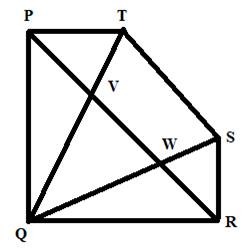
Concept Used:
Intersections of a ray and a line are the points common between them.
Since a ray moves in one direction which have one initial point but no terminal point.
Calculation:
Here, the ray QV meets the line TS in T, hence
Conclusion:
b.
To Find: The missing terms.
b.
Answer to Problem 4PSA
Explanation of Solution
Given:
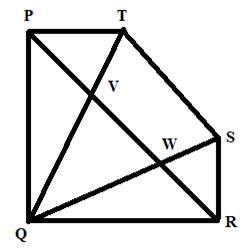
Concept Used:
Intersections of two line segments are the portion of the line segments common between them.
Calculation:
Here, the intersections of two line segments WP and VR is a line segment VW
Conclusion:
c.
To Find: The missing terms.
c.
Answer to Problem 4PSA
Explanation of Solution
Given:
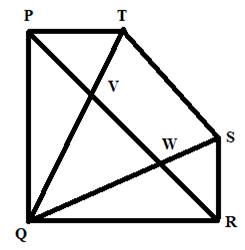
Concept Used:
Union of two different rays with different initial points is a line.
Calculation:
Here, the rays WP and VR and coinciding with each other, thus we get a line with their union.
Conclusion:
d.
To Find: The missing terms.
d.
Answer to Problem 4PSA
Explanation of Solution
Given:
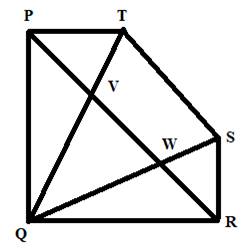
Concept Used:
Union of two different rays with common initial points is a
Calculation:
Here, the rays SQ and SR are passing through a common initial point, thus we get an angle with their union.
Conclusion:
e.
To Find: The number of angles the vertex Q have.
e.
Answer to Problem 4PSA
Six angles formed at the vertex Q.
Explanation of Solution
Given:
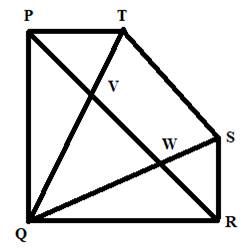
Concept Used:
A angle is formed when two different rays passes through the same point, i.e., rays having same initial point.
Calculation:
Here, the rays QR, QW, QS, QV, QT and QP are passing through a common initial point Q, thus we get different angles using the vertex Q. Thus, the angle formed at the vertex Q are
Thus six angles formed at the vertex Q.
Conclusion:
Six angles formed at the vertex Q.
Chapter 1 Solutions
Geometry For Enjoyment And Challenge
Additional Math Textbook Solutions
Elementary Statistics
Elementary Statistics (13th Edition)
A Problem Solving Approach To Mathematics For Elementary School Teachers (13th Edition)
Calculus for Business, Economics, Life Sciences, and Social Sciences (14th Edition)
Calculus: Early Transcendentals (2nd Edition)
Basic Business Statistics, Student Value Edition
- 39 Two sides of one triangle are congruent to two sides of a second triangle, and the included angles are supplementary. The area of one triangle is 41. Can the area of the second triangle be found?arrow_forwardA parallelogram with an area of 211.41 m^2 hast a base Thatcher measures 24.3m. Find ist height.arrow_forwardBH is tangent to circle A and DF is a diameter. I don't know where to go from here. May you help please?arrow_forward
 Elementary Geometry For College Students, 7eGeometryISBN:9781337614085Author:Alexander, Daniel C.; Koeberlein, Geralyn M.Publisher:Cengage,
Elementary Geometry For College Students, 7eGeometryISBN:9781337614085Author:Alexander, Daniel C.; Koeberlein, Geralyn M.Publisher:Cengage, Elementary Geometry for College StudentsGeometryISBN:9781285195698Author:Daniel C. Alexander, Geralyn M. KoeberleinPublisher:Cengage Learning
Elementary Geometry for College StudentsGeometryISBN:9781285195698Author:Daniel C. Alexander, Geralyn M. KoeberleinPublisher:Cengage Learning

